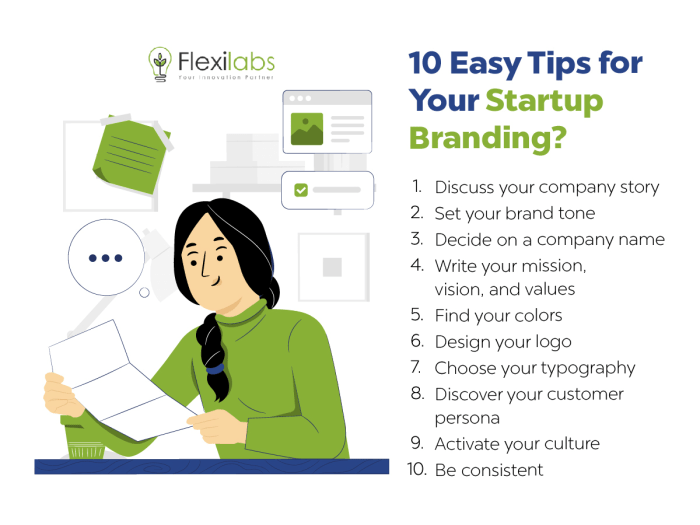Branding for Startups sets the stage for success in a competitive world, where creating a unique identity is key to attracting attention and loyalty. Dive into the realm of branding strategies with us as we explore the essentials of building a brand from the ground up.
From crafting a memorable logo to understanding your target audience, this guide will equip you with the tools needed to make your startup shine in a sea of competitors.
Importance of Branding for Startups

Branding is essential for startups as it helps them establish a strong identity in the market. A well-defined brand can differentiate a startup from its competitors, create trust with customers, and build loyalty over time.
Examples of Successful Startups with Effective Branding Strategies
- One great example is Airbnb, which transformed the way people think about travel accommodations with its unique branding and messaging. Their logo, website design, and marketing campaigns all contribute to a cohesive brand image that resonates with their target audience.
- Another successful startup with a strong brand is Warby Parker. They disrupted the eyewear industry by offering affordable, stylish glasses online. Their branding focuses on innovation, social responsibility, and customer experience, setting them apart from traditional eyewear companies.
How Branding Helps Startups Stand Out in a Competitive Market
Branding can help startups stand out in a crowded market by creating a memorable and distinctive identity. A strong brand can attract customers, investors, and top talent, giving startups a competitive advantage. Additionally, branding helps startups communicate their values, mission, and unique selling propositions effectively, setting them apart from competitors.
Building a Brand Identity
Building a strong brand identity is crucial for startups to stand out in a crowded market. A brand identity encompasses various components that work together to create a distinct and memorable image for the company.
Components of a Strong Brand Identity
- Logo: The logo is often the first thing people notice about a brand and serves as a visual representation of the company. It should be simple, memorable, and reflective of the brand’s values and personality.
- Colors: The color palette used in branding can evoke different emotions and associations. Startups should choose colors that align with their brand message and appeal to their target audience.
- Typography: The fonts selected for branding materials play a significant role in conveying the brand’s tone and style. Consistent use of typography helps establish brand recognition.
- Visual Elements: Beyond the logo, visual elements such as icons, patterns, and imagery contribute to the overall brand identity and create a cohesive look across all platforms.
Creating a Unique Brand Voice and Personality
- Know Your Audience: Understanding your target market is essential in developing a brand voice that resonates with them. Tailor your messaging to appeal to their preferences and values.
- Be Authentic: Authenticity is key to building trust with consumers. Stay true to your brand values and mission in all communications to establish a genuine connection with your audience.
- Show Personality: Infuse your brand with personality to differentiate yourself from competitors. Whether it’s humor, sincerity, or innovation, let your unique voice shine through in all brand interactions.
Importance of Consistency in Branding
Consistency is vital in branding to create a cohesive and recognizable brand image. Whether it’s on social media, marketing materials, or customer interactions, maintaining consistency in messaging, visuals, and tone helps build brand trust and loyalty. By presenting a unified brand identity across all platforms, startups can establish a strong brand presence and make a lasting impression on their audience.
Target Audience and Branding: Branding For Startups

Understanding the target audience is crucial when developing a branding strategy for startups. By identifying the specific demographic, psychographic, and behavioral characteristics of the target audience, startups can tailor their branding efforts to resonate with potential customers.
Methods for Identifying Target Audience
- Conduct surveys and questionnaires to gather information about customer preferences and behaviors.
- Utilize social media analytics to track engagement and identify key demographics interacting with the brand.
- Engage in focus groups or interviews to gain deeper insights into the needs and desires of the target audience.
- Analyze competitor data to identify gaps in the market and potential opportunities to target specific segments.
Aligning Branding with Target Audience
- By aligning branding with the target audience, startups can create messaging and visuals that resonate with their potential customers.
- Developing a brand identity that reflects the values and preferences of the target audience can lead to better customer engagement and loyalty.
- Effective communication tailored to the target audience can help build trust and credibility, ultimately driving brand growth and success.
Branding Strategies on a Budget
In the competitive world of startups, establishing a strong brand identity is crucial for success. However, many startups operate on limited resources, making it challenging to invest heavily in branding efforts. To overcome this obstacle, it is essential to adopt cost-effective branding strategies that can maximize impact without breaking the bank.
Utilizing Social Media Platforms
In today’s digital age, social media platforms offer a cost-effective way for startups to reach a wide audience and build brand awareness. By creating engaging content, leveraging hashtags, and interacting with followers, startups can increase their visibility without the need for a large budget.
Collaborating with Influencers, Branding for Startups
Partnering with influencers in the industry can be a powerful branding strategy for startups on a budget. Influencers already have a dedicated following, and their endorsement can help boost brand credibility and reach a new audience. This collaboration can be a win-win situation for both parties without requiring a significant financial investment.
Utilizing User-Generated Content
Encouraging customers to create and share content related to the brand is another effective way to build brand awareness on a budget. User-generated content not only showcases authentic experiences with the brand but also helps in creating a sense of community around the brand. This strategy can be a cost-effective way to engage with customers and promote brand loyalty.
